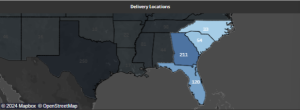Market Update June 2025
Industry Market Trends
GENERAL MARKET TRENDS
Fuel Index:
- Diesel National Averages:
- This Week: $3.45/gallon
- Last Week: $3.49/gallon
- Weekly Change:
 $0.04
$0.04 - Year-over-Year Change:
 $0.44
$0.44
Summary: U.S. diesel prices declined again, continuing a steady downward trend. Midwest and Gulf Coast saw the largest price drops due to stabilizing crude prices and increased refinery output. Canadian diesel sits around $4.01/gal USD (↓12.6% YoY), while Mexican diesel is up at $5.07/gal USD (↑5.0% YoY), still influenced by refinery bottlenecks and subsidy tapering.
Outlook: Tariff-related volatility and global fuel cost moderation are keeping domestic diesel price changes relatively stable.
Reference: Gasoline and Diesel Fuel Update – U.S. Energy Information Administration (EIA)
RPM Monthly Movers:
- National RPM Month-to-Month Changes:
- Dry Van Markets (May – June)
 $0.05
$0.05 - Reefer Markets (May – June)
 $0.02
$0.02 - Flatbed Markets (May – June)
 $0.03
$0.03
- Dry Van Markets (May – June)
POTENTIAL MARKET DISRUPTORS
Seasonal Trends:
As Q2 reaches its close, the freight market shows signs of regional volatility rather than broad-based momentum. Flatbed and reefer markets remain the tightest segments, with LTRs still historically high despite post-Roadcheck cooldowns. Produce volumes are gradually picking up but remain compressed compared to prior years, especially out of California and Mexico. Construction and energy sectors continue to support flatbed volume, while van markets remain uneven, largely driven by retail and import demand near port hubs.
- Reefer: Capacity remains tight across most of the U.S. as late-season berry, melon, and citrus crops move through key outbound regions (California, Texas, Florida). LTRs remain elevated, but rates are under pressure due to retail softness and delayed harvest surges. Watch Nogales, McAllen, and Lakeland for volume pressure into July.
- Flatbed: Still the strongest modal segment. Industrial freight, steel, and project cargo out of Texas, Alabama, and Georgia continue to hold rates near seasonal highs. While LTRs dipped from May peaks, demand remains elevated from housing, manufacturing, and Gulf infrastructure work.
- Dry Van: Capacity is starting to tighten slightly around Gulf and East Coast port regions (Houston, Savannah, Norfolk) due to modal shifts from intermodal and tariff-bypassing strategies. However, national van capacity remains loose overall. Retail restocking remains inconsistent, with signs of overstock in some Midwest warehouses suppressing volume.
Other Disruptors:
- Steel & Aluminum Tariffs Expanded: On June 1, the Trump administration announced expanded tariffs on steel and aluminum, targeting imports from Europe and East Asia. This move is expected to raise costs for U.S. manufacturers and put pressure on Midwest flatbed lanes hauling inbound industrial and construction freight.
- U.S.–China Tariff Pause Holds: The 90-day pause on new tariffs remains in effect following the May 10 U.S.–China rollback agreement. Most Chinese import tariffs remain reduced at 45–65%, down from the prior 125%, easing pressure on import-heavy modes.
- Cross-Border Freight Conditions: Border inspection delays have eased, with wait times now averaging 2–4 hours at Laredo and Nogales. However, brokers should still quote live due to tariff-related customs variability.
- Reefer and LTL volumes are stable into and out of Mexico, supported by ongoing nearshoring trends.
- Outbound truckload softness is being partially offset by stronger LTL compliance and parts shipments.
- Port Diversions & Inland Shift: West Coast ports (LA, Long Beach, Oakland) remain subdued with blank sailings and weaker China bookings still prevalent.
Gulf and East Coast ports (Houston, Savannah, Norfolk, Ensenada) continue gaining share, funneling more FTL volume inland to Dallas, Atlanta, and Chicago hubs. These modal shifts are contributing to tighter regional capacity and inconsistent rate behavior near transload zones.
MARKET PREDICTIONS & RATE TRENDS
Capacity & Rate Trends:
Dry Van:
- Capacity: Gradually firming in Southeast and Gulf regions as retail restocking and port realignment flows increase.
- Rates: Overall Flat, Rates are up MoM .05 but still lowest amongst equipment types.
- Forecast: Expect continued rate stagnation in oversupplied regions (Northwest, West Coast), but modest firming in Gulf and transload markets.
Reefer:
- Capacity: Tightening continues: LTR at 9.13.
- Rates: Down slightly, .02 MoM, 2025 volumes are lagging that of 2024
- Forecast: Peak season pressure to continue through mid-July, especially out of Nogales, Central California, and Lakeland.
Flatbed:
- Capacity: LTR dropped to 25.88, still highest nationally.
- Rates: Up slightly by .03 MoM
- Forecast: Energy, infrastructure, and housing demand continue to support high utilization across Texas and Southeast. Tariff-driven reshoring may provide upside near industrial zones.
Overall Capacity Rebalancing & Forecast:
- Dry Van: Capacity has loosened post-Roadcheck, but watch for tightening near Gulf Coast and East Coast ports as retail restocking and inland port flows increase into late June.
- Reefer: Capacity remains tightest since early Q1, driven by compressed late-season produce from California, Florida, and Mexico. Expect continued strain through early July as berry and citrus volume persists.
- Flatbed: Nationally softening slightly, but still well above average. Capacity remains tight regionally in Texas, the Gulf, and Southeast industrial zones, supported by construction and energy demand.
- Cross border freight: Lanes remain volatile amid tariff uncertainty. Although border wait times have improved, live quoting is still critical — especially for lanes tied to automotive, LTL, and reefer commodities.
- LTL: Strong and stable. Aftermarket parts, nearshoring shipments, and compliance-sensitive freight from Mexico and Canada are driving consistent volume, particularly in border regions like Laredo, Detroit, and Nogales.
Key Takeaways:
- Dry Van Demand: Sluggish demand keeps rates soft; watch Southeast and Gulf for tightening.
- Reefer Demand: Late bloom produce surge has extended seasonal volume through June; however, spot rates dipped slightly.
- Flatbed Demand: Still outperforming; construction and energy zones continue to drive demand.
- Tariff Impacts: Steel and aluminum measures reintroduced, risking industrial freight cost escalations.
Port Adjustments & Supply Chain Rebalancing:
- West Coast:
- LA/Long Beach: Still operating at 20–30% below Q1 averages, weighed down by weak transpacific volumes, elevated blank sailings, and importers preferring tariff-sheltered ports.
- Seattle/Tacoma: Activity remains flat; no notable rebound in volumes or diversification. Rail intermodal out of the Northwest remains underused.
- Outlook: Without a tariff rollback or recovery in China imports, expect subdued volumes and continued modal leakage to Gulf and East Coast.
- East Coast:
- Savannah & Charleston: Continue to gain share aggressively. Both are absorbing freight from NY/NJ and West Coast shifts, due to lower congestion, faster inland access, and fewer customs hold-ups.
- Virginia: Emerging as a compliance-friendly alternative, particularly for retail and LTL replenishment freight.
- Outlook: East Coast growth is expected to remain steady, especially as nearshoring boosts demand for faster U.S. inland distribution via these corridors.
- Gulf Coast:
- Houston: Stable volumes. Benefiting from re-routed Asian imports via Ensenada and increased cross-border traffic from Mexico.
- Veracruz & Ensenada: Now seeing a measurable bump in transload activity, especially for Mexico–Asia container freight. These ports are becoming strategic bypass hubs for shippers avoiding the LA basin.
- Outlook: Gulf ports will stay hot through summer, especially for energy, automotive, and construction linked imports.
Transportation Events |
Upcoming Holidays |
| GS1 Connect: Nashville, TN, June 10-12
Jarrett Supply Chain Summit: North Canton, OH, June 18 CSCMP EDGE 2025: National Harbor, MD, October 5-8 |
Independence Day, July 4
Labor Day, September 1 |
BM2 NEWS
Bonded Freight & Customs Clearance
BM2 specializes in bonded freight solutions across the U.S., Canada, and Mexico—helping you defer tariffs, accelerate customs clearance, and keep your supply chain competitive. Whether you’re moving auto parts, electronics, industrial goods, steel, or perishables, our in-bond expertise ensures your shipments get where they need to go, on time and tariff-efficiently.
Why Choose BM2?
- Expedited bonded drayage at all major ports and airports
- Customs expertise, including complete in-bond documentation and compliance
- Robust cross-border network for reliable transport throughout North America
- Duty deferral strategies to avoid delays and reduce landed costs
BM2 News & Highlights
- Cross-Border Specialists: We excel at U.S.–Mexico shipments, leveraging our dedicated carrier partners to navigate uncertain trade policies and ensure seamless deliveries.
- In-Bond Authority: From origin to destination, BM2 manages secure, compliant in-bond transportation—so your goods maintain supply-chain integrity every step of the way.
- High-Volume Performance: With over 700 same-day bonded shipments processed monthly, BM2’s optimized systems and partner network meet even the most demanding timelines without sacrificing accuracy.
INDUSTRY NEWS TO KNOW
Gasoline and Diesel Fuel Update – U.S. Energy Information Administration (EIA)
Canada diesel prices, 02-Jun-2025 | GlobalPetrolPrices.com
Mexico diesel prices, 02-Jun-2025 | GlobalPetrolPrices.com
CargoNet | The cargo theft prevention and recovery network
State of Freight Today (ftrintel.com)
US ports by volume: How maritime cargo trends are stacking up | Supply Chain Dive
Truck Tonnage Index (TRUCKD11) | FRED | St. Louis Fed (stlouisfed.org)
All Employees, Truck Transportation (CES4348400001) | FRED | St. Louis Fed (stlouisfed.org)
E-Commerce Retail Sales (ECOMSA) | FRED | St. Louis Fed (stlouisfed.org)
United States LMI Logistics Managers Index (tradingeconomics.com)


